Hertfordshire
ST ALBANS

St Albans Abbey
St Albans started life as the Roman city of Verulamium, a day's march up Watling Street from London for the legions. A Roman theatre and sections of the wall can still be seen, and the museum displays splendid mosaic floors excavated from Roman villas.
Around the year 250, a Christian priest traditionally called Amphibalus was on the run from his persecutors and sought shelter with Alban, a citizen of Verulamium. Impressed by the lifestyle of his uninvited guest, Alban was converted to Christianity and baptised. The two men later swapped clothes, enabling the priest to escape in disguise. Refusing to worship the pagan gods of Rome, Alban was beheaded on a hill outside the city, where the Abbey now stands. He is remembered as the first recorded English martyr.
A shrine on the site of Alban's martyrdom attracted a steady stream of pilgrims, and the first monastery was commissioned by Offa, King of Mercia in 793. Following the Norman Conquest, a much grander building was ordered by Archbishop Lanfranc, who installed his nephew Paul of Caen as the first abbot. In medieval times, the monastery buildings covered a wide area and the town grew up to serve the needs of pilgrims. Following the Dissolutionof the Monateries by Henry VIII in 1536, the site was plundered as a source of building material. The Abbey church gradually fell into ruin, requiring extensive renovations in the nineteenth century, which were financed by a local magnate called Lord Grimthorpe.

Abbey, West Front
The present Abbey complex is a mixture of styles and periods covering nearly a thousand years. Standing in the nave, we can see a sharp contrast between the Norman pillars on the north side, many with paintings, and the later ones on the south. The tower is Norman, built of Roman bricks and tiles gathered from Verulamium, while the Chapter House is twentieth century. The Gothic-looking West front is actually late Victorian. The Abbey Gateway nearby is the only remaining fragment of the extensive monastic buildings. Towards the east end of the Abbey is the reconstructed shrine of St Alban, overlooked by an unusual wooden gallery, formerly used by monks to check on pilferers. In the adjacent north aisle, a shrine to Amphibalus has been reconstructed from fragments recovered during renovations. In both transepts there are ringed baluster columns in the walls which may have come from Offa's Saxon foundation.
Facing the Abbey Gateway is a semicircular garden called Romeland. Here, another martyrdom took place although the memorial is rather more modest than that of Alban. George Tankerville, a baker, was burned at the stake as a Protestant in the reign of Queen Mary in 1555. A slab of grey slate set into the wall facing the Abbey records the event. Tankerville is also depicted as one of seven brightly coloured statues of martyrs on a screen in the nave of the Cathedral. The others include Alban and Amphibalus.
A short walk from the west end of the Abbey is College Street named after the "College" or sanatorium run by Dr Nathaniel Cotton in the eighteenth century. This was a humane attempt to treat the mentally ill with care and compassion, in marked contrast to the grim asylums of the day. One of Cotton's patients was the poet and hymn writer William Cowper, who spent two years here from 1763 to 1765, during one of his long bouts of depression. The site on the corner of Lower Dagnall Street is now occupied by a modern office building.
BERKHAMSTED
The historic High Street of Berkhamsted cuts through a gap in the Chilterns, with the railway line and Grand Union Canal running parallel. Dr John Cowper was rector of St Peter's Church (HP4 2AX) for thirty-four years in the eighteenth century and his son, the poet William Cowper, was born here in 1731. The east window was installed in memory of Cowper and there is also a memorial to the poet's mother Ann.
The church welcomes visitors, but unfortunately the east end is closed off by wooden panelling which is normally kept locked, so the window is not easily visible.
CHORLEYWOOD
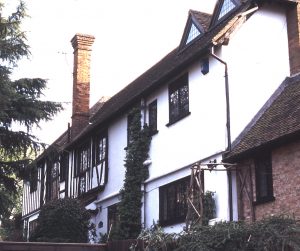
King John's Farm
Just north of the M25, Chorleywood now consists mainly of modern commuter belt houses, but on the southern edge, at the intersection of Berry Lane and Shepherd's Lane is a late medieval building with wings added in the twentieth century. Now called King John's Farm (WD3 5HA), it was here that the Quaker William Penn married Gulielma Springett in 1672. The house is privately owned but the room where the ceremony took place is believed to be largely unchanged. On the east facade of the house is an interesting coat of arms and an adjacent property is called Penn Cottage. Following their marriage, the Penns took up residence in nearby Rickmansworth.
RICKMANSWORTH
The town is clearly proud of its links with William Penn (1644-1718), Quaker statesman and founder of Pennsylvania. There is a William Penn School, a William Penn Leisure Centre and a pub in the High Street called the Pennsylvanian. Amidst a complex of civic buildings in the centre stands Basing House (WD3 1HP), built in 1740 on the site of Penn's first marital home, where he lived from 1672 to 1677. It has an impressive frontage, with seven windows on the first floor. One half of the building is used as council offices and the other is a small museum with a biographical display of Penn's life and a 1726 edition of his collected writings.

Basing House
William Penn cuts a strange figure in Stuart England. He was the son of a distinguished admiral and on familiar terms with the highest nobility in the land including Charles II and his brother, later James II. As a student at Christchurch, Oxford, he heard a Quaker sermon which determined the course of his life. Oxford banished him, and his father sent him abroad to forget Quakerism. Non-conformist preaching was banned at the time and he suffered under the same laws that confined John Bunyan in Bedford Gaol. Penn's connections did not save him from several spells of imprisonment. He also antagonised other Christians by challenging certain fundamental points of doctrine.
On the death of his father, Penn received a grant of land in America from Charles II in lieu of a debt of £16,000 owed by the King. He used this to found the state of Pennsylvania as a refuge for Quakers and other persecuted groups, with Philadelphia as its capital. He made two visits to America in 1682-84 and 1699-1701 and negotiated honourable treaties with native tribes.
Penn pleaded for complete freedom of conscience and was a persistent open air preacher of Quaker beliefs. He used his influence to secure the release of Quakers and others from imprisonment. He had high hopes of religious freedom on the accession of James II in 1685, but was shocked by the brutality following the Duke of Monmouth's rebellion. When James was deposed by the Glorious Revolution of William III in 1688, Penn lost his friend and patron and again found himself in prison, this time for debt. His final years were marred by ill-health and disputes over the future of Pennsylvania.
JOHN BUNYAN IN HERTFORDSHIRE
The "immortal tinker" of Bedford is known to posterity as the author of Pilgrim's Progress, but his literary achievements were the incidental fruit of long periods of imprisonment. He would rather have been out preaching in the fields and cottages and, when not confined in gaol, he usually was. While Bedfordshire was the main focus of Bunyan's ministry, his labours extended into Hertfordshire and further afield. Remarkably, several existing Baptist churches in both Hertfordshire and Bedfordshire trace their origins to Bunyan's work.

Bunyan's chimney
Two miles north of St Albans is the hamlet of Coleman Green. Here, the chimney of a ruined cottage where Bunyan held meetings survives in the corner of a field. Opposite, the John Bunyan pub commemorates his links with the spot (AL4 8ES).
A few miles further north is the village of Breachwood Green. The Baptist Church in Chapel Road (SG4 8NU) with its ugly mock perpendicular facade has a pulpit that Bunyan used for preaching in a nearby barn.
Close by is the village of Preston and on the northern outskirts is Wain Wood. A footpath runs through the wood and alongside it, there is a large overgrown amphitheatre probably formed by ancient flint workings. Bunyan had friends in the village and clandestine meetings were conducted here. The spot can be reached from Chequers Lane, taking a footpath on the right where the houses come to an end.

Wain Wood
The Baptist Church (SG5 2EE) in Upper Tilehouse Street, Hitchin, was founded in 1669 and has an impressive frontage with classical half-columns erected in 1844. Inside is a chair Bunyan gave to the minister of the day. In the graveyard behind the chapel lies Agnes Storey (born Agnes Beaumont), a devoted follower of Bunyan. The site of the grave is lost but a memorial stone was set into the outside west wall of the church in 1812. It recalls a person justly celebrated for her eminent piety and remarkable sufferings. We tell her story at Edworth in Bedfordshire.
WATTON AT STONE
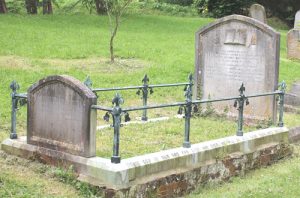
Bickersteth graves
The fine flint church of St Mary and St Andrew (SG14 2RJ) stands proudly on a slope on the south side of the village, with horses grazing in the field below. Three generations of the evangelical Bickersteth family are buried here. Edward Bickersteth (1786-1850) came here as vicar in 1830 and remained until his death twenty years later. After ordination in 1815, he was a keen supporter of the newly formed Church Missionary Society and visited Sierra Leone on their behalf. He helped to found the Evangelical Alliance in 1845 and published a popular collection of hymns. A plaque on the south wall of the chancel records his achievements, and records that he is interred near this spot without the walls, although no headstone is visible outside.
Nearby are the graves of Bickersteth's son and daughter-in-law. Edward Henry Bickersteth (1825-1906) followed in the same tradition. He was vicar of Christchurch, Hampstead, for thirty years and then Bishop of Exeter from 1885 to 1900. He is remembered for the devotional hymn Peace, perfect peace and also a long visionary poem Yesterday, today and forever. Edward Henry's wife Rosa lies next to him. She died in 1873, aged only forty-seven, and the headstone poignantly records the deaths of four of their daughters, aged between eight months and nineteen years.
WADESMILL
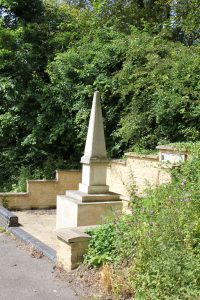
Thomas Clarkson memorial
It might seem strange to commemorate a man getting off his horse for a rest, but a curious monument beside the A10 just north of Wadesmill does just that (SG12 0TP). Thomas Clarkson (1760-1846) passed this way in 1785. He was returning to London after his Latin essay on slavery had been received with great acclaim at Cambridge. As he pondered beside the road, he realised that academic exercises were not enough. He decided there and then to devote the rest of his life to the abolition of the iniquitous trade. As he later described, I sat down disconsolate by the roadside and held my horse. Here a thought came into my mind that if the contents of my essay were true, it was time some person should see these calamities to their end.
For the next fifty years, he relentlessly pursued facts and arguments against the trade which he fed to William Wilberforce, Granville Sharp and others, and lived to see his efforts crowned with success. Successive Acts of Parliament banned first the slave trade and finally slavery itself.
The memorial was restored to commemorate the 200th anniversary of the slave trade Abolition Act in 2007. It now has a smart surround of Cotswold stone, a new plinth and a display board describing the significance of Clarkson's journey and his subsequent career. A shiny new seat has been provided - perhaps in case others should wish to sit down and think of changing the world for the better.
WIDFORD
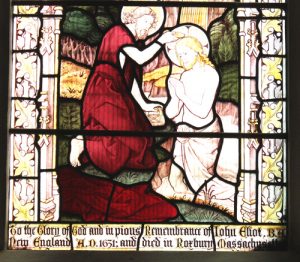
John Eliot window
Located between Ware and Bishop's Stortford, this little village was the birthplace of John Eliot, known as the Apostle of the [American] Indians. He was baptised in the church of St John the Baptist (SG12 8RL) on August 5th 1604. In 1894 the east window of the church was restored in his memory by his American descendants. It shows scenes from the life of Christ, with an inscription to Eliot underneath.
Eliot emigrated to New England in 1631, only a decade after the Pilgrim Fathers, and while many in America at the time were preoccupied with mere survival, Eliot was intent on taking the gospel to the native American tribes. He even translated the scriptures into one of their languages and his collection of Psalms was the first book ever printed in America. He lived to a grand old age and, as the inscription records, died at Roxbury, Massachusetts, in 1690. We meet him again at Little Baddow in Essex.
HADLEY
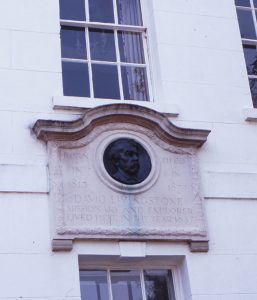
Livingstone Cottage
Two nineteenth century giants of faith and endurance found some respite from their labours here in the leafy lanes of Hertfordshire. In 1857, David Livingstone was on his first visit home after sixteen years in Africa and found himself the centre of much attention and acclaim. To find some peace and also write a book of his travels, he took a house overlooking Hadley Green. During breaks in his writing he would take walks with his children in Hadley Wood, playing hide-and-seek among the trees as if it was the African jungle. The white-painted house, now called Livingstone Cottage, has a plaque with a relief portrait of the explorer, unveiled by his daughter in 1913 to commemorate the centenary of his birth (EN5 5PY).
From 1903 until his death in 1912, William Booth, founder of the Salvation Army, lived at large semi-detached house called Rookstone, in Lancaster Avenue, Hadley Wood. He was by now an elderly widower, but he kept up a punishing schedule of preaching and travel, much of it overseas. The house carries a blue plaque but is otherwise unremarkable (EN4 0ES).


